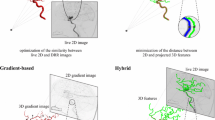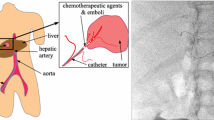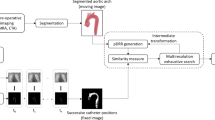Abstract
We present the first clinical results obtained with a novel technique: the three-dimensional [3D] roadmap. The major difference from the standard 2D digital roadmap technique is that the newly developed 3D roadmap is based on a rotational angiography acquisition technique with the two-dimensional [2D] fluoroscopic image as an overlay. Data required for an accurate superimposition of the previously acquired 3D reconstructed image on the interactively made 2D fluoroscopy image, in real time, are stored in the 3D workstation and constitute the calibration dataset. Both datasets are spatially aligned in real time; thus, the 3D image is accurately superimposed on the 2D fluoroscopic image regardless of any change in C-arm position or magnification. The principal advantage of the described roadmap method is that one contrast injection allows the C-arm to be positioned anywhere in the space and allows alterations in the distance between the x-ray tube and the image intensifier as well as changes in image magnification. In the clinical setting, the 3D roadmap facilitated intravascular neuronavigation with concurrent reduction of procedure time and use of contrast medium.







Similar content being viewed by others
References
Grass M, Koppe R, Klotz E et al (1999) Three-dimensional reconstruction of high contrast objects using C-arm image intensifier projection data. Comput Med Imaging Graph 23:311–313
Maintz JB, Viergever MA (1998) A survey of medical image registration. Med Image Anal 2(1):1–36
Kerrien E, Vaillant R, Launay L, Berger M-O, Maurincomme E, Picard L (1998) Machine precision assessment for 3D/2D digital subtracted angiography images registration. SPIE Medical Imaging ‘98, San Diego, USA, February 1998
Ziedses des Plantes BG (1934) Planigraphie en Subtractie. Röntgenografische Differentiatie Methoden. Thesis, University of Utrecht
Ziedses des Plantes BG (1968) The significance of subtraction in neuroradiology [in German]. Radiologe 8(11):333–335
Ziedses des Plantes BG (1968) The application of the subtraction method to cerebral angiography. Prog Brain Res 30:181–188
Meaney TF, Weinstein MA, Buonocore E et al (1980) Digital subtraction angiography of the human cardiovascular system. AJR Am J Roentgenol 135(6):1153–1160
Tobis J, Johnston WD, Montelli S et al (1985) Digital coronary roadmapping as an aid for performing coronary angioplasty. Am J Cardiol 56(4):237–241
Wallman H, Wickbom I (1966) Electronic subtraction. Acta Radiol Diagn (Stockh) 5:562–569
Cornelis G, Bellet A, van Eygen B, Roisin P, Libon E (1972) Rotational multiple sequence roentgenography of intracranial aneurysms. Acta Radiol Diagn (Stockh) 13(1):74–76
Saint-Felix D, Picard C, Ponchut C, Romeas R, Rougée AYT (1993) Three dimensional X-ray angiography: first in vivo results with a new system. SPIE Med Imaging 1897:90–98
Anxionnat R, Bracard S, Macho J et al (1998) 3D angiography. Clinical interest. First applications in interventional neuroradiology. J Neuroradiol 25(4):251–262
Picard L, Maurincomme E, Soderman M et al. (1997) X-ray angiography in stereotactic conditions: techniques and interest for interventional neuroradiology. Stereotact Funct Neurosurg 68(1–4 Pt 1):117–120
Bakker NH, Tanase D, Reekers JA, Grimbergen CA (2002) Evaluation of vascular and interventional procedures with time-action analysis: a pilot study. J Vasc Intervent Radiol 13(5):483–488
Author information
Authors and Affiliations
Corresponding author
Rights and permissions
About this article
Cite this article
Söderman, M., Babic, D., Homan, R. et al. 3D roadmap in neuroangiography: technique and clinical interest. Neuroradiology 47, 735–740 (2005). https://doi.org/10.1007/s00234-005-1417-1
Received:
Accepted:
Published:
Issue Date:
DOI: https://doi.org/10.1007/s00234-005-1417-1




